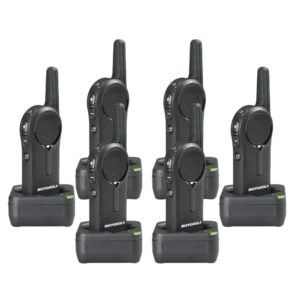
 As we've mentioned in previous articles, podcasts and videos, the Motorola DLR1020 and DLR1060 radios can be great assets for many different types of businesses. In this article, we will note some of the many pros, as well as the few cons, that these radios have.
As we've mentioned in previous articles, podcasts and videos, the Motorola DLR1020 and DLR1060 radios can be great assets for many different types of businesses. In this article, we will note some of the many pros, as well as the few cons, that these radios have.
One of the biggest pros of the Motorola DLR series radios is that they operate on 900 MHz digital frequencies. This feature is beneficial in several ways. First, consider the level of privacy that these frequencies offer. The 900 MHz frequencies are much less common than standard UHF or VHF frequencies, and the FHSS "frequency hopping" method used by these radios allows you to completely eliminate any chance of unwanted interference from neighboring two-way radio users.
Second, these 900 MHz radios do not require any type of FCC licensing. This saves you hundreds of dollars in licensing fees and allows you to use the radios as-is, "out of the box", with minimal, if any, programming required.
Third, because the DLR series radios are digital, the sound quality is impeccable. You will find that there is no background static or "white noise" like you may experience with normal analog radios.
Another major plus is the ultra-compact size of the Motorola DLR radios. They are very small and incredibly lightweight, making them practical for use in almost any situation. Even with their small size and light weight, these units offer military-grade specs for durability and resistance against dust, water, vibration, shock, and extreme temperature variations. Like many of the other Motorola onsite business radios, the DLR radios have antimicrobial housings to inhibit the growth of mold and bacteria.
With all the pros, there are also a few cons. One disadvantage of the Motorola DLR radios is their low power. The transmit power of radios that operate on this 900 MHz band is limited to 1 watt by the FCC. This means they are not practical for very large industrial job sites. Also, the FHSS frequency hopping technology will not work with typical repeaters, limiting the possibility of extending their range.
Perhaps the biggest con would be the lack of cross-compatibility with an existing fleet of two-way radios operating on standard business frequencies. Based on their rather unique frequency hopping capabilites and the fact that they operate on 900 MHz frequencies instead of the UHF or VHF business bands, they are not universally compatible with other digital radios. Also, most companies still tend to use analog radios, which these digital units will not communicate with at all. The Motorola DLR technology is cross-compatible with only one other line of radios, the Motorola DTR series.
On the plus side, if you happen to already have Motorola DTR series radios such as the DTR600 or DTR700, the DLR line will work with them and will be a much sleeker, smaller, more affordable option.
With all this being said, the pros of the Motorola DLR1020 and DLR1060 radios far outweigh the cons, and tend to be an excellent option for almost any on-site business use!


















Not even Motorola can answer the first part of the question, since it's the FCC that limits license-free 900 MHz ISM FHSS radios to 1 watt. In my experience, in many scenarios especially involving dense structures like cruise ships and high rise office buildings, 1 watt DLR and DTR radios far outperform the range of 4 watt UHF analog or DMR radios anyway, because 900 MHz FHSS is better at penetrating such structures despite their lower power.
Will the 1060 ever be updated, perhaps as a 2 watt radio and micro USB charging?
That's a question only Motorola can answer. It's not likely.
I am interested in using the Motorola DLR radios for a football officiating crew. I've noticed that when testing various earpiece mics, there is an an echo when I use the security style - acoustic tube style. I would like to utilize a boom type mic earpiece but options seem limited.